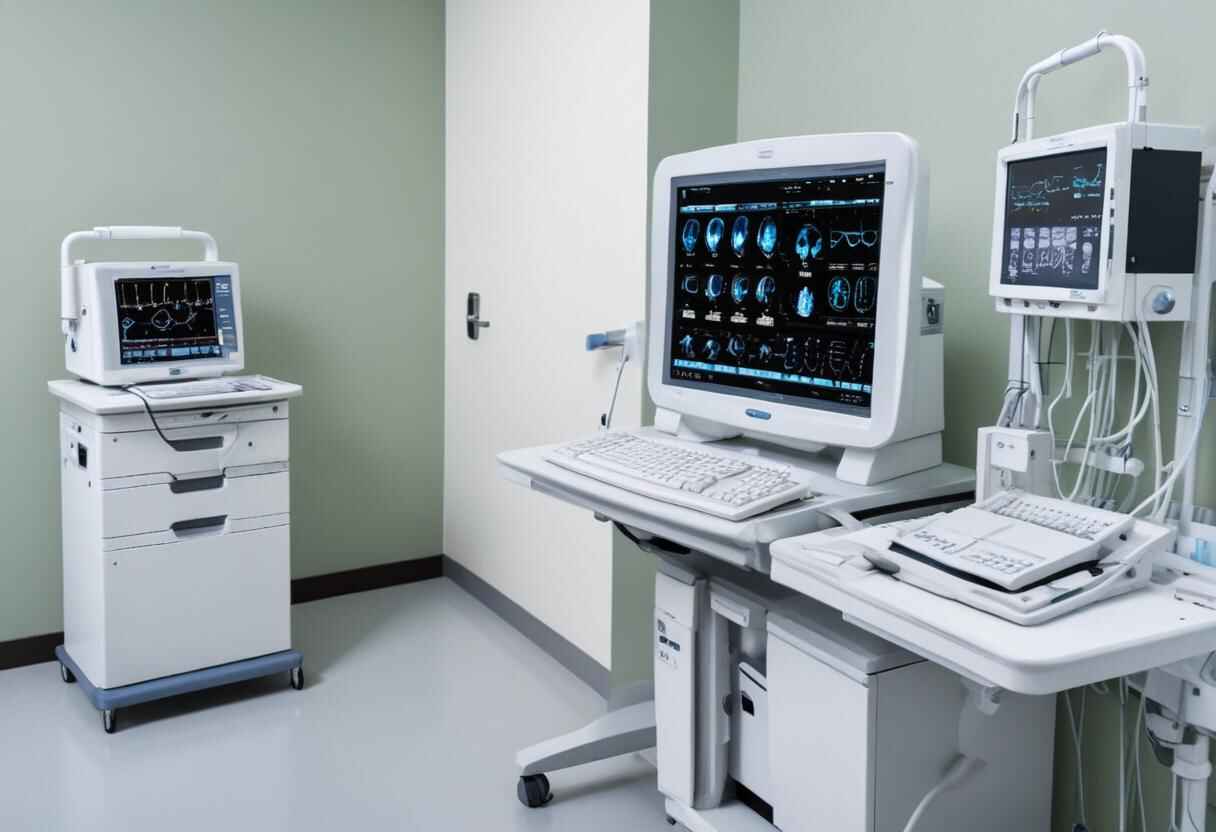In the constantly changing field of medicine, diagnostic equipment is crucial for accurately finding and diagnosing health problems. Healthcare professionals use these devices every day to make quick and precise diagnoses, which helps create effective treatment plans. Here, we look at eight common types of medical diagnostic equipment, explaining what they do and why they are important in today’s healthcare.
MRI (Magnetic Resonance Imaging)
MRI machines use powerful magnets and radio waves to create detailed pictures of organs, tissues, and bones inside the body. They are very helpful in diagnosing issues with the brain, spine, joints, and soft tissues. MRI scans produce clear images without using radiation that could harm patients, so they are safe to use many times for medical checks.
CT (Computed Tomography) Scan
CT scanners use X-rays and computers to create detailed, cross-sectional pictures of the body. These images are crucial for finding bone and joint problems, internal injuries, tumors, and issues with blood vessels. CT scans are fast and effective, giving healthcare providers important information about the body’s structures and any problems.
Ultrasound
Ultrasound machines use high-frequency sound waves to make live pictures of organs, blood flow, and tissues inside the body. They are commonly used in pregnancy to check how a baby is growing and find any issues that might come up. Ultrasound also helps diagnose problems with the heart, abdomen, and muscles and bones without needing surgery or other invasive methods.
X-Ray
X-ray machines use a special kind of radiation to look inside the body and make pictures of bones, teeth, and some soft tissues. They are very important for finding fractures, lung infections such as pneumonia, dental problems, and certain types of cancer. X-rays are valuable because they are fast, convenient, and provide clear images of solid parts inside the body.
EKG/ECG (Electrocardiogram)
An EKG or ECG machine tracks the heart’s electrical signals over a period. This helps find irregular heartbeats, spot heart problems, and check how well the heart muscle is working. EKGs are very important for diagnosing issues like irregular heart rhythms, heart attacks, and heart disease. They help doctors act quickly to treat these conditions.
Pulse Oximeter
Pulse oximeters check how much oxygen is in a person’s blood and their heart rate. These small devices are often used in emergencies, intensive care, and surgeries to watch how well someone’s breathing and oxygen levels are. They give fast, painless information about how much oxygen someone has, helping find breathing problems and low oxygen levels early.
Endoscope
Endoscopes are tubes with a light and camera that doctors use to see inside the body’s organs and spaces. They’re used in tests like colonoscopies, gastroscopies, and bronchoscopies to find problems in the digestive system, lungs, and urinary tract. Endoscopes let doctors see directly, take tissue samples, and sometimes treat issues without surgery.
Blood Pressure Monitor
Blood pressure monitors are important devices that check systolic (when the heart contracts) and diastolic (when the heart relaxes) blood pressure levels. They help find high blood pressure, watch heart health, and see how well treatments are working. Blood pressure checks are done at clinics and at home to catch heart risks early and plan care for each person.
What are Medical Diagnostic Equipment and Medical Devices
Medical diagnostic equipment includes a wide range of tools used by healthcare professionals to find, watch, and treat different medical problems. These tools range from simple ones like thermometers and blood pressure monitors to complex machines like X-rays, MRIs, and CT scanners. Medical devices, on the other hand, cover more things, from simple bandages and syringes to high-tech things like pacemakers and insulin pumps that can be put in your body. Both kinds of tools are really important in healthcare today. They help doctors find problems right, treat them well, and make sure patients get better.
Why is Medical Diagnostic Equipment Vital in Healthcare?
Medical diagnostic equipment is crucial in healthcare for several important reasons:
- Accurate Diagnosis: These tools help doctors accurately find diseases, conditions, and injuries. This is crucial for making the right treatment plans and giving care quickly.
- Early Detection: It’s easier to treat many diseases if they are detected early. Diagnostic tools help find conditions like cancer, heart disease, and infections early, which helps patients get better faster and costs less in the long run.
- Monitoring and Managing: For long-term health problems, diagnostic equipment helps watch how a disease gets worse and how well treatments work. This lets doctors change treatments when needed, so patients get better results.
- Deciding on Treatment: Test results from these tools help doctors choose the better treatments and care for each person.
- Preventive Care: Screening tests from diagnostic tools are important for stopping problems before they start. They find risks for diseases early so doctors can stop them before they happen.
Conclusion
Medical diagnostic equipment includes a variety of advanced tools that help doctors diagnose and treat many medical conditions accurately. From imaging machines like MRI and CT scans to important tools like EKGs and blood pressure monitors, each device is vital for providing precise and timely medical care. As technology gets better, these tools will improve even more, becoming more useful in hospitals and clinics. By using new ideas and combining tools, diagnostic medical equipment stays important in medicine, making patients healthier and care better around the world.
